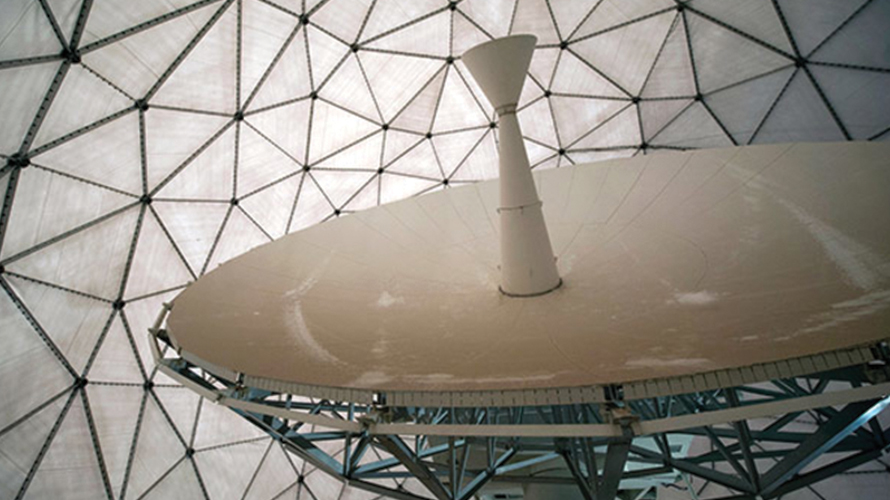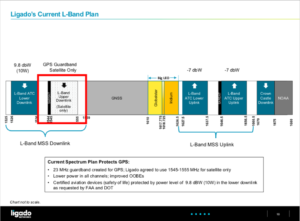 UPDATED TO INCLUDE STATEMENT FROM REP. MAC THORNBERRY
UPDATED TO INCLUDE STATEMENT FROM REP. MAC THORNBERRY
WASHINGTON: The FCC has tentatively approved plans to build a 5G mobile communications network by Ligado that the Pentagon — and much of the rest of the federal government — has vociferously insisted will interfere with GPS receivers.
FCC Chairman Ajit Pai today circulated a draft order that would approve, with conditions, Ligado’s application to build a terrestrial Internet of Things (IoT) network using the firm’s L-Band spectrum allotment originally approved for use by satellites.
“After many years of consideration, it is time for the FCC to make a decision and bring this proceeding to a close,” Pai said in a press statement.
“Although I appreciate the concerns that have been raised by certain Executive Branch agencies, it is the Commission’s duty to make an independent determination based on sound engineering,” he added. “And based on the painstaking technical analysis done by our expert staff, I am convinced that the conditions outlined in this draft order would permit Ligado to move forward without causing harmful interference.”
The US military has opposed versions of this system for almost a decade and recently restated that opposition.
“It is DoD’s position that FCC approval of Ligado’s license modification would cause unacceptable operational impacts to the warfighter and adversely affect the military potential of GPS by negatively impacting GPS receivers,” stated a Feb. 10 letter signed by Air Force GPS Executive Agent Thu Luu. The letter was sent to the National Telecommunications and Information Administration (NTIA) for transmittal to the FCC.
The draft ruling, which will require a formal vote by the five FCC commissioners, essentially agrees with Ligado’s scathing rebuttal to Pentagon claims — which the company asserts are based on outdated Air Force tests and technically flawed assumptions.
“We commend Chairman Pai for his leadership and his vision, and we look forward to engaging with the other Commissioners to drive this process forward,” said Ligado CEO Doug Smith said in a statement today. “The central importance of mid-band – especially our lower mid-band – to 5G is well-known,” he added. “We urge the FCC to work together now to make this a reality as soon as possible.
UPDATE BEGINS. The draft ruling, however, piqued a strenuous objection from Rep. Mac Thornberry, ranking member of the House Armed Services Committee, in a statement issued this evening.
“Much of America’s national security and economic security depends on the GPS system. That is why all the major federal agencies, including the Department of Defense and the Intelligence Community, oppose Chairman Pai’s draft order. They know that this flawed effort will harm our security while failing to advance 5G development,” he said.
“We must advance 5G development, but this is not the way to do it,” he added. “The FCC cannot be allowed to overrule the unanimous opinion of America’s national security leaders. If they do, Congress should immediately revisit and revise their authority.” UPDATE ENDS.
In an April 12 letter to the FCC from Ligado’s legal counsel, Ligado argued that the Pentagon based its claims on classified Air Force tests undertaken in 2016, which used an earlier, higher-powered version of Ligado’s planned system. The company updated its proposal in 2018, the letter argues, to lower the network’s power usage in the radio frequency bands closest to GPS by 99 percent.
Pai agreed, explicitly stating that his draft order “would authorize downlink operations at a power level that represents a greater than 99% reduction from what Ligado proposed in its 2015 application.”
Company officials and expert supporters — including at the White House — say the Pentagon has failed to provide technical information that would prove Ligado’s latest receiver configuration would bleed enough into GPS’s radio frequency (RF) to cause harmful interference. There is strong support at the White House for a faster American 5G system to answer the challenge posed by China’s Huawei’s offerings, which the Trump administration has opposed on national security grounds.
Ligado supporters further have argued that the standard being used by the Air Force and the Pentagon to judge the level of signal “noise” that would harm GPS is overly conservative by orders of magnitude — to the point that DoD is essentially arguing that any radio system nearby would jam the GPS signal. This is particularly ironic, these sources say, given that DoD and contractor Lockheed Martin have recently been crowing about updates to the GPS network that improve its anti-jam features.
The Ligado letter, signed by Gerard Waldron of the high-powered Covington and Burling LLP law firm, also blasts NTIA for blindly following DoD’s lead in an April 10 FCC filing. The NTIA filing, as first reported by colleagues Aaron Mehta and Mike Gruss, reviewed a series of protests from top DoD officials — including CIO Dana Deasy and Undersecretary for Research & Engineering Mike Griffin — and concludes that NTIA is “unable to recommend the Commission’s approval of the Ligado application.”
“Raising no new evidence, no new arguments, and no new claims, the NTIA Submission is based entirely on unsupported and overblown claims of threats to the military use of GPS, irrelevant statutory references, and assertions that somehow the NTIA-led interagency review deprives the Commission of its rightful role as the ultimate and exclusive decision-maker on commercial spectrum issues,” claims Waldron.
The company’s letter also made two other key arguments:
- Ligado’s latest proposal leaves a wide swath of RF spectrum between that used by its downlinks and that assigned to GPS. This, experts say, leaves room for signals from the system to attenuate enough to ensure that any “noise” being picked up by GPS receivers is insignificant.
- The power level now proposed by Ligado (9.8 dBW as opposed to 32 dBW) has been certified by the Federal Aviation Administration as safe for aviation receivers — in contrast to the Air Force’s claim otherwise. (Ligado further argues in its letter that it has reached co-existence agreements with most makers of GPS receivers.)
The latest back-and-forth regarding the FCC’s rule-making process is the latest salvo in a long-running battle that dates all the way back to 2010, when Ligado’s previous incarnation, LightSquared, first made a bid to convert L-band spectrum approved by the FCC for its satellite network to terrestrial use to create a 4G network. That proposal was shot down by the FCC in 2012 based on DoD objections about the impacts to GPS receivers but only after an intense, and highly political, skirmish.
Since that time, Ligado was formed from LightSquared’s ashes, under new CEO Smith, and with a new plan for its L-band spectrum that would allow the firm to break into the emerging 5G marketplace for enabling the Internet of Things. Ligado first applied for an FCC license based on that new plan in 2015.
Ligado currently operates three satellites using midband-range L-band spectrum, including SkyTerra 1, in Geosynchronous Orbit (GEO), a company representative told me. Its 5G concept would link those satellites to a vast network of devices for use not by average consumers, the source explained, but by commercial industries, utilities and even government organizations to provide coverage in remote areas such as Alaska.
In recent years, as Sydney has reported extensively, the issue of beating China to the 5G punch has risen to a top political priority of the Trump Administration — along with concerns that China’s telecoms behemoth Huawei not only was cornering the international market but also inserting ‘back doors’ into its equipment that allow it to spy on foreign users.
President Trump on April 4 signed an executive order that created a new Committee for the Assessment of Foreign Participation in the United States Telecommunications Services Sector, surprisingly chaired by Attorney General William Barr, to ensure against national security risks from foreign (read Chinese) telecoms companies operating in the US.
Barr — who once worked as chief legal council to telecoms giant Verizon — has publicly supported the use of L-band for 5G mobile networks. Indeed, in a Feb. 11 letter to White House economic advisor Larry Kudlow, Ligado cites remarks by both Barr and former NASA Administrator Dan Goldin in support of using L-band “to reduce the time and cost to build out 5G.”
L-band signals, used by the US Global Positioning System and other positioning, timing and navigation (PNT) systems such as Europe’s Galileo, are less likely to be degraded by clouds, fog and rain and can pass through heavy foliage.
The FCC did not respond to requests seeking comment on when a final decision might be handed down. DoD declined to comment beyond its written communication to the FCC.
‘The bad day’: DISA’s forthcoming strategy prepares for wartime coms
“It’s great to have internet day to day in peacetime,” said Lt. Gen. Robert Skinner, director of the Defense Information Systems Agency, “but it’s more imperative to have it when bullets are flying.”


























